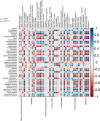The Influence of Gut Microbiota on the Fecundity of Henosepilachna vigintioctopunctata (Coleoptera: Coccinellidae)
- PMID: 34415303
- PMCID: PMC8378403
- DOI: 10.1093/jisesa/ieab061
The Influence of Gut Microbiota on the Fecundity of Henosepilachna vigintioctopunctata (Coleoptera: Coccinellidae)
Abstract
The gut microbiota of insects usually plays an important role in the development and reproduction of their hosts. The fecundity of Henosepilachna vigintioctopunctata (Fabricius) varies greatly when they develop on different host plants. Whether and how the gut microbiota regulates the fecundity of H. vigintioctopunctata was unknown. To address this question, we used 16S rRNA sequencing to analyze the gut microbiomes of H. vigintioctopunctata adults fed on two host plant species (Solanum nigrum and Solanum melongena) and one artificial diet. The development of the ovaries and testes was also examined. Our results revealed that the diversity and abundance of gut microorganisms varied significantly in insects reared on different diets. The gut microbiota of H. vigintioctopunctata raised on the two host plants was similar, with Proteobacteria being the dominant phylum in both groups, whereas Firmicutes was the dominant phylum in the group reared on the artificial diet. The predominant microbiota in the S. nigrum group were Acinetobacter soli and Acinetobacter ursingii (Acinetobacter, Moraxellaceae); Moraxella osloensis (Enhydrobacter, Moraxellaceae); and Empedobacter brevis (Empedobacter, Weeksellaceae). The microbiota in this group are associated with high lipid metabolism. In addition, the beetles' ovaries and testes were more highly developed in the S. nigrum group than in the other two groups. These findings provide valuable information for elucidating the complex roles the gut microbiota play in the fecundity of H. vigintioctopunctata, and may also contribute to developing future novel control strategies involving this economically important pest.
Keywords: Henosepilachna vigintioctopunctata; diet; gut microorganism; reproduction.
© The Author(s) 2021. Published by Oxford University Press on behalf of Entomological Society of America.
Figures





References
-
- Beenakkers, A. M. T., Horst D. J. V. D., and Marrewijk W. J. A. V.. . 1981. Role of lipids in energy metabolism, 53–100. In Roger G. H. Downer, Energy Metabolism in Insects. Springer, Boston, MA, America.
-
- Behar, A., Yuval B., and Jurkevitch E.. . 2005. Enterobacteria-mediated nitrogen fixation in natural populations of the fruit fly Ceratitis capitata. Mol. Ecol. 14: 2637–2643. - PubMed
-
- Behar, A., Yuval B., and Jurkevitch E.. . 2008. Gut bacterial communities in the Mediterranean fruit fly (Ceratitis capitata) and their impact on host longevity. J. Insect Physiol. 54: 1377–1383. - PubMed
MeSH terms
Substances
Grants and funding
LinkOut - more resources
Full Text Sources

